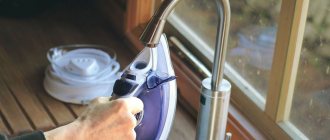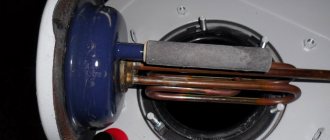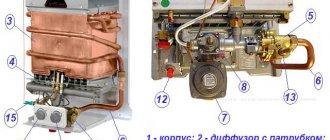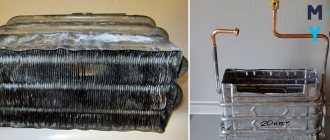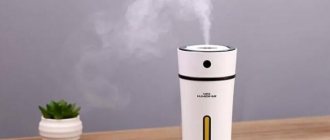Hello, dear ones!
Today’s article will be about how to clean an Ariston boiler with a capacity of 10 liters.
The fact is that during operation, scale and decomposition products of the magnesium anode form in the tank. In the photo at the end of the article you can see how much has accumulated in our water heater over 3 years of operation. I, of course, expected to see something like this, but what will happen...
Naturally, in order to clean the boiler, you can call a specialist. But what, how he will do it and how much money he will take for it is unknown. Yes, and doing everything with your own hands is not so difficult, the main thing is not to be afraid.
How to know when it's time to cleanse
Installing a hot water boiler is half the battle.
It is important to ensure regular maintenance. Tap water containing an abundance of calcium, magnesium salts and other inclusions is hard
The salts contained in tap water settle on the boiler parts and interfere with its normal functioning.
Important! If you neglect cleaning, the water heater will sooner or later fail. You will have to buy a new boiler, and this purchase is far from cheap.
To understand when it's time to clean your water heater, pay attention to the following points:
- The water began to heat up more slowly than before.
- The device turns off spontaneously and then turns on again. This is a very ominous sign, a signal to immediately clean the device from the accumulated scale.
- The device makes strange noises during operation. This is evidence that some parts of it are not working correctly.
- The water has acquired a foreign odor and an uncharacteristic dark hue.
- If you have been using the boiler for more than 1-1.5 years, then you need to clean it, even if the water heater is fully operational.
Important! Before cleaning the Ariston boiler, be sure to study its structure and circuitry, since the device will have to be disassembled.
Cleaning Ariston and Termex boilers
How and how to clean sewer pipes at home
Owners have many questions about how to clean a water heater of different brand models, for example, Ariston, Termex, and what features they have. You will learn about this below.
Actually, the process itself is not much different for all models and is carried out according to standard rules.
The first thing we will consider is how to clean an Ariston boiler at home. As with all other devices of this type, all work begins with disassembly.
In Ariston water heating equipment, the flange is attached differently. To disconnect it, you need to push the flask up, turn it clockwise in the container and pull it towards you.
The boiler and other components are cleaned according to standard items. Installation must be done step by step in reverse order.
An interesting video will show you how to clean an Ariston boiler using a screwdriver and two keys.
Cleaning the heating element and flushing the Termex boiler is carried out in the same standard way. is held once a year. In order to extend the service life of the tubular electric heater, a filter is installed.
You will learn how to clean a Thermex water heater from scale in the video.
Now you know how to clean an Ariston and Termex water heater
But after carrying out all the procedures, it is important to remember the following points: . Electricity can only be supplied if the container is completely filled with liquid.
Otherwise, failure to comply with the requirements may result in damage to the tubular electric heater. After complete assembly, you need to leave the boiler filled with water to function for another couple of hours. Be sure to do this under supervision, to ensure that the structure does not leak. At the end, the boiler must be flushed.
- Electricity can only be supplied if the container is completely filled with liquid. Otherwise, failure to comply with the requirements may result in damage to the tubular electric heater.
- After complete assembly, you need to leave the boiler filled with water to function for another couple of hours. Be sure to do this under supervision, to ensure that the structure does not leak.
- At the end, the boiler must be flushed.
All operations are carried out with the utmost care and caution so that there is no need for expensive repairs. .
Boiler assembly
The boiler must be assembled in the reverse order of disassembly. After the boiler is assembled, do not forget to check the water heater for leaks. Fill the tank with water and leave for 24 hours. If it doesn’t leak, it means you did everything right.
The efficiency of its operation depends on how responsibly you approach cleaning the boiler. If you are not confident in your own knowledge and skills, it is better to contact a specialist.
Important! When disassembling the boiler, be sure to photograph or video the process. In this case, assembly will be much less labor-intensive.
Connecting the boiler after cleaning
Combination boiler
In order to reconnect the boiler, you need to do all the previous manipulations in reverse order. The assembled device must be checked for leaks, and, if the test is successful, water and electricity must be connected to it. In order to check the device for leaks, you need to let the filled water heater stand for 2-3 hours. If a leak is detected, the culprit is most likely the rubber flange gasket. You will have to spend some time searching for a gasket in a special store and then replacing it. When the boiler is connected to the power supply, you need to ensure that the thermostat is activated when the required temperature is reached.
If the heating element has not been cleaned for a long time, excessive scale build-up may render it unusable. In this case, all that remains is to replace it. When purchasing a new heating element, you should choose a similar device with the same power. You should immediately check the length of the contacts that are connected to the thermostat. We must not forget that improper cleaning of the heater can lead to electric shock and even explosion of the water heating device.
If a water heater leaks, you should pay attention to the magnesium anode, which is located near the heating element and is a metal rod. A magnesium anode is needed to initiate a chemical reaction that restores the protective layer of the internal walls of the boiler tank
During the operation of any boiler, the anode is destroyed and must be replaced. The service life of the anode depends on the intensity of use of the device. A leak indicates that the anode is faulty and requires replacement. In this case, you need to unscrew the anode and screw a new one in its place.
We disassemble the boiler
Boiler: features of choice
After draining all the liquid contained in the water heater and removing the device from the wall, it must be disassembled. How to disassemble the boiler before cleaning?
Follow the following instructions:
- First of all, you need to unscrew the bolts holding the front cover of the device.
- Then you need to remove the panel that is located near the thermostat.
- Removing the thermostat holder and protective door. A diagram will appear before your eyes - you need to photograph it with your phone.
- Disconnecting the electrical wire.
- Removing grounding.
Afterwards you can pull out the rubber seal and the heating element itself with the flange. Next you need to start cleaning.
Step by step instructions
Draining water from the boiler
The first thing to do is drain the water heater. To do this, you need to use the safety valve on the cold water supply, if it has a manual release handle, or turn off the hot water valve, then unscrew the reinforced hose from the cold water supply (if soldered, an American adapter) and open the second valve.
A boiler with a volume of 80 liters is emptied through a safety valve within 3 hours. In all other cases, the water flow is regulated manually using a previously preinstalled valve.
Removing the protective cover and disconnecting the temperature sensor supply
To do this you will need a shaped screwdriver. After unscrewing all the screws from the lid, the main mount to the seat of the heating element will open and access to the inside of the tank will open. As soon as the fastening is dismantled, overcoming the force of the sealing rubber, the heating element itself is removed, on the body of which an additional magnesium anode is installed.
Removing the tank
After all the above steps, the tank is removed from the wall. This is necessary for more thorough independent maintenance and high-quality cleaning under running water of accumulated dirt and salt deposits.
As soon as the tank is on the ground, a bucket of water is poured into it, after which the entire container is washed with an ordinary rag, and so on several times. After the surface deposits have been removed, you can begin to treat the scale-affected surfaces using one of the mentioned means. It is enough to follow the instructions and also avoid products that contain phosphates.
Cleaning the heating element from scale
The largest amount of scale deposits always concentrates on the walls of the heating element, simultaneously destroying the anode. After removing scale from this functional unit mechanically, the remains of the magnesium anode are removed to install a new one (replacement is mandatory).
As for the heating element itself, to fully clean it you will need to select any container, fill it with a previously used descaling agent, but at the same time exceeding the concentration by 3 or more times. The heating element is lowered into the prepared solution for the next 3-4 hours.
If you can’t wait 3 hours, you can heat the liquid solution or even bring it to a boil. An old electric kettle will also work for this. The fumes are extremely toxic, so you need to protect your respiratory system or leave the room altogether.
Such simple manipulations will help you completely get rid of scale in the shortest possible time, while returning the boiler to its previous efficiency and energy savings.
How to clean
There are several products that can be used to clean boilers.
Folk
People who do not want to use chemical detergents use folk remedies.
Vinegar
Acetic acid is an effective solution for cleaning your water heater. When creating a working mixture, you need to dilute vinegar with water in a ratio of one to three. Then moisten a sponge in the solution and wipe the surface with plaque.
Lemon acid
A cleaning solution made from citric acid will help remove scale and clean the surface of plaque. To prepare the mixture, you need to add 5-7 grams of acid to a liter of warm water. The liquid is thoroughly stirred until the citric acid is completely dissolved.
Soda with vinegar
Sometimes the boiler is flushed with a liquid made from vinegar and soda. When creating the product, add 100 milliliters of acetic acid and 80 grams of soda to a liter container of water. Then the walls of the water heater are washed with the solution.
Professional
To get rid of scale faster, use professional detergents.
Filtero
To remove scale and clean the inside of boilers, use Filtero. It comes in powder form, which must be dissolved in warm water before use.
Topper 3031
This product is designed specifically for cleaning water heating equipment from scale deposits. The features of this detergent composition include:
- effective plaque removal;
- absence of toxic components in the composition;
- ease of use.
Bagi Kumkumit
To combat corrosion and scale, you can use Bagi Kumkumit. This is a concentrated and effective composition that can restore the surface of boilers, coffee makers, kettles and even irons. Bagi Kumkumit should be used at least once a month.
"Melon ZhS17"
This product should be used if the boiler has not been cleaned for several years. "Melon" is considered a highly concentrated product that removes scale, traces of fungus, mold, corrosion and many other contaminants.
"Silit"
This is a universal cleaning composition that helps clean surfaces from stubborn dirty stains, rusty deposits and scale. The advantages of Silit include the fact that it can restore the original shine of the coating.
"Eona Bio"
"Eona Bio" is a high-quality cleaner used for washing household appliances. The components included in this powder allow you to quickly remove scale. Before use, a sachet of “Eona Bio” is diluted in a liter of water.
Bagi Schumanit
A popular detergent composition used by many housewives to remove grease stains and scale deposits. You can wash your water heater with Schumanit no more than twice a month.
"Solita"
To clean boilers and geysers, many people use the Solita cleaner. The product contains components that corrode even old scale.
What are the best products to use?
The basic rule for any product remains the absence of phosphates, which not only corrode the water supply tubes, but also negatively affect the internal protective coating or enamel coating. Among the most popular it is worth noting:
- Glutoclean (liquid substance for cleaning any coatings, including irons);
- Sano Anti Kalk Kettle;
- Tortilla;
- REDD Stirovit;
- InterTechKomplekt ANTINAKIPIN.
The principle of operation of all these funds remains the same
It is necessary to carefully treat the surface that is covered with scale, including paying attention to the dismantled heating elements. After this, after the period of time indicated on the package, the boiler tank is washed with several buckets of water and wiped with a rag.
If scale remains on the walls and, especially, the bottom, the process must be repeated, increasing the exposure time by another 10-15 minutes.
During the cleaning process, the contents of the boiler can be poured into the bathtub or washbasin, since descaling agents are selected for their environmental friendliness and neutral effect on all types of materials, including cheap acrylic.
Final Steps
After completing cleaning of the heating element, whether manually or mechanically, clean the tank of dirt. The walls of the boiler are descaled as desired.
Lime on the walls of the device smoothes out the wear of the device and thus extends its service life. In addition, scale prevents rust from forming on the inner metal surface and also helps keep the water in the tank hot longer.
The boiler has been descaled. You can forget about this problem for two or three years.
Cleaning the tank
Before you start cleaning the inner walls of the tank at home, you should determine the degree of contamination by shining a flashlight inside. If the deposits are small, then you do not need to remove the water heater. To begin with, rinse it from the inside using a shower head, and then wipe the mucus off the walls with a cloth soaked in soapy water.
Do not scrub the tank with abrasives. This will lead to scratches that will cause corrosion of the material.
If the contamination is serious, then the tank is removed and cleaned with improvised means.
Algorithm of actions:
- mix vinegar with water in a ratio of 1:10;
- connect the hose to the drain fitting;
- use it to pour the prepared solution into the tank, while the hose should be higher than the boiler;
- the filled tank is left for a day;
- Afterwards, the solution must be drained and the inside walls rinsed with clean water.
You can also use the following composition: 5 g of citric acid for every liter of water.
Alternative option without disassembly
You can also use folk remedies to clean the device. Some of them (for example, table vinegar or citric acid) work no worse than professional products. In this case, the solution is simply poured into the container, remains there for 2 to 12 hours, and then is washed out. But care must be taken, since a solution that is too concentrated can corrode the walls of the boiler.
Important! Focus on the proportions of 5 g of citric acid powder per 1 liter of water poured.
What you need to descale your boiler
- Curly screwdriver.
- Key for 10-12 (depending on the assembly - American, European).
- 17mm wrench for disconnecting reinforced water supply hoses.
- Bucket or any other container.
- Screwdriver with voltage indicator.
- Gloves.
- New protective magnesium anode (recommended to be replaced every year to reduce rust).
This list of tools and accessories is relevant for both wall-mounted and floor-standing models. Once there is no more water in the heater, its weight does not exceed 22.5 kg (any model), eliminating the need for outside assistance.
For cleaning, the mounted boiler must be removed and turned upside down to remove the heating element and assess the scale of the work. It is better to do this in a bathtub or other large container, after placing a soft cloth under the product to prevent deformation of the body.
Expert advice
In order for you to be able to use your boiler longer, you need to adhere to several rules that will help you not destroy the device ahead of time.
Buy a water purification filter, which comes in two types:
- the reagent filter is based on chemicals that oxidize iron, manganese and hydrogen sulfide, thereby softening the water;
- a reagent-free filter converts substances into an oxidized form, which makes it possible for them not to settle on the surface; therefore, it is more expensive.
Reagent filter
Reagent-free filter
And a few more tips:
- change the anode regularly;
- use maximum temperatures to eliminate bacteria;
- to remove an unpleasant odor, pass its full volume through the tank once every two months;
- use a scale filter.
Boiler selection
Let's try to find the right option together. If you need to purchase a water heater for the kitchen and use it for washing dishes and cutlery, a volume of 10-15 liters will be enough for you so as not to heat water that we do not use.
For one person, 50-80 liters of water is enough, but a family will need a 100-liter model. The size of the room is also of great importance; if it is small, immediately discard the “pot-bellied” options.
Cleaning a boiler without outside help is not at all difficult, but still, do not forget about the consequences, since cleaning too late will bring you many complications. Another thing is if you carry out this procedure once a year, then your equipment will last a long time and you can save your money and time. Successful use and long service life!
Competent operation
To increase the service life of your equipment, use our tips:
- Install reagent filters. Their cartridges contain water softening agents. Significant replacement of cassettes can help improve water quality. Filters with sodium resin are considered very effective.
They produce reagent-free filters. They emit a strong magnetic field, salt particles change shape and do not settle on the surface. Such products are much more expensive.
- When purchasing, pay attention to the material of the tubular heater. Galvanized and ferrous metal is more likely to rust.
- Magnetic external water thermostats work best.
Proper operation prevents problems with the heater. Therefore, follow the manufacturer's advice.
How to understand that the boiler needs cleaning
Firstly, you should know that preventative cleaning of your water heater should be carried out at least once a year. If you clean it once every six months, it’s even better for the device! And if it’s better for him, then it’s better for your pocket, you know. After all, buying a new heating element or other parts, as well as paying for the work of a replacement specialist, is very expensive.
Secondly, there are various methods designed to improve the quality of water and soften it, so that you don’t have to clean the boiler so often. These include:
- Filters for mechanical cleaning at the inlet
- Ion or sorption filters
- Magnetic water converters
- Cationic additives and other regents
But these products do not purify water 100%, and you will still need to clean it mechanically. True, less often.
But, if you simply didn’t know this and the boiler has been in operation for quite a long time, then you probably began to notice such signs that directly indicate that the urgent “time” has come:
- You have noticed that your electricity consumption has increased noticeably. After all, a layer of scale of just 1 mm increases light consumption by 10%, but an annual layer of 10 mm increases the light consumption by 70%!
- You began to notice that the tank heats up very slowly. This is also because a large “fur coat” has formed on the shade, greatly complicating heat transfer. In addition, the boiler in this case works much more intensively than necessary, and thereby shortens its service life.
- Some noises and hissing are heard from the boiler.
- If there is a magnesium anode there, and it looks significantly thinner, then it needs to be cleaned immediately.
When is the best time to contact a specialist?
The design of the boiler is not complicated, but not in all cases it is possible to cope with problems and clean it yourself. Calling a plumber is justified if there is a water leak or the device does not turn on.
A qualified specialist will carry out diagnostics using a special tester without disassembling the water heater. The malfunction of the heating element can only be determined using the device. If a part burns out due to scale, the technician will replace it. Repair of a failed tube is not carried out.
The cause of the malfunction may lie in the temperature sensor. If after the measurements it turns out to be faulty, you will have to purchase a new water heater.
The specialist will also inspect other systems and help identify faults. After repair, the boiler will be cleaned of deposits using mechanical or chemical methods. The choice depends on the customer and the volume of the tank.
Cleaning the boiler from scale means extending its service life and ensuring proper operation of all device control systems. Regular flushing of the water heater will prevent the formation of a dense layer of scale, which reduces efficiency. Experts recommend combining the chemical method with the mechanical method to achieve maximum results. Analysis is carried out once a year, treatment with chemicals every 3-6 months.
Use of auxiliary chemicals or folk remedies
Disassembling/assembling the device can be difficult and time-consuming, and mechanical cleaning may be ineffective. In this case, the tank can be cleaned without disassembling using cleaning products. Household chemicals include special products:
- Master Boiler;
- Nast;
- Cillit;
- Topper;
- Cinderella Antiscale.
All of the listed cleaners have the same properties and are used in a similar way:
- the boiler is emptied by a third;
- the solution is poured through the hose attached to the fitting;
- The mixture is kept inside for several hours.
After this, the tank is rinsed several times, draining and filling with water. During the last rinse, the device must be turned on, warmed up and the water drained. Only after this can the boiler be used for its intended purpose. Cleaners prepared independently using improvised means are also used:
- citric acid;
- vinegar;
- soda;
For a home cleaner, you will need about half a kilo of one of the listed products, which must be dissolved in two liters of water.
Important! When using soda-based cleaners, it is important to ensure that the powder is completely dissolved. Otherwise, invisible microcracks may appear that can affect calcification.
Necessary tools and tools
Boiler with dry heating element
A boiler with a “dry” heating element is easier to clean - it will be enough to clean the tank, since the heating element itself is isolated from direct contact with water. Designs with a conventional heating element, in principle, take the same amount of time to clean, but sometimes it is better to disassemble the boiler and remove the heating element in order to better clean it.
At home, it is easier to use a method that does not require disassembling the water heater. To do this, it is recommended to use a weak acid (citric or acetic acid). The cleaning process is carried out in several steps:
- Attach a hose to the splitter and clamp it with a clamp for a tight fit. In this case, the hot water valve should not be closed.
- Drain some of the water from the tank by closing the valve through which water is supplied to the tank. In large volume boilers (100 liters or more), 30% of the liquid is drained.
- Make a solution of citric acid in hot water at the rate of 250 g per 1 liter.
- Pour the solution into the tank through the hose. To do this, it is convenient to use a watering can or funnel. In order for water to easily flow from the watering can into the tank, it must be located above the water level in the tank (according to the principle of communicating vessels). The water drainage taps must be closed.
- After this, open the cold water valve to fill the tank, and turn on the boiler to the electrical network.
- The boiler starts working. After it heats the water to the set temperature, it must be left for several hours so that the liquid dissolves the scale.
- After this, you need to empty the tank and refill it, and then empty it again. It is enough to repeat this procedure 2-3 times.
If after a short period of time the boiler begins to work the same as before cleaning, the magnesium anode may need to be replaced. The fact is that it is designed to minimize the appearance of rust and scale, as it attracts cations so that the heating elements and tank walls do not deteriorate for a long time. But over time, naturally, it itself becomes unusable and ceases to perform its direct function. After replacing it, the device will work normally again.
If it is not possible to clean the structure yourself, it is recommended to call a specialist.
It is better to clean a instantaneous water heater chemically. No disassembly is required. To do this, you need to disconnect it from the network and pour the same solution through the tube as into the boiler. Taking into account the fact that plaque deposits in pipes more slowly, its layer will be smaller and the pipes will be cleaned faster. The tank itself of a flow-through design is also smaller, so it will be enough to interrupt its operation for only 2-3 hours. After this, it is recommended to flush as much water as possible so that all dissolved sediment flows out of the pipes.
Video description
The result of cleaning with citric acid is shown in this video:
This is a very effective method that does not require large financial and physical costs.
Cleaning the tank
Before you start cleaning the inside of the water heater body, you need to inspect its walls. If there is a small amount of deposits, it is enough to simply flush the boiler. Using a sponge or rag, you need to wipe the entire surface to remove dirt and mucus. After this, just rinse everything off with water.
How to flush the inside of a water heater if it is seriously damaged by scale can be found in the section on cleaning heating elements with chemicals. You can use professional descaling solutions. There are quite a lot of them and they can all cope with such a task. The exact dosage can be found on the packaging or in the instructions.
However, not everyone knows how to properly flush a boiler with such liquids. This refers to the method of filling them into the tank. This cleaning option is used without disconnecting the water heater body from the water supply system. However, here too the question arises about the correct connection of the boiler. If all installation rules are followed, then the water from the tank is drained to a third through the hot water supply tap.
Next, a hose is connected to the drain hole and through it the solution is poured directly into the tank. In order for the liquid to penetrate inside the tank, the hose must be raised above the boiler.
You can pour the solutions into the tank manually after cleaning with a sponge and let it sit for 6 hours (a method of cleaning with liquid products with the boiler removed) Source cosmo-frost.ru
In addition to specialized products, homemade solutions are also used. The most effective solution is considered to be citric acid. You need to take 50 g of powder and dissolve it in 1 liter of water. The resulting solution is poured into the tank and infused for 24 hours. After the specified time, the water from the tank is drained, and the inside is washed with water.
Folk
Next, unscrew the hose supplying hot water. The boiler must be removed from its installation site and placed on the floor with the taps up. You can proceed to the next stage of disassembly.
Expert opinion
Ksenia Diyanova, expert on beauty, purity, harmony
Ask me any questions, I will be happy to answer!
After installing the heating element and sealing the boiler, it is necessary to install it in its original place. Cleaning your boiler from scale using a cleaner will make the job more efficient and save you time. How to disassemble a boiler? Ask me all your questions, I will be happy to answer!
Cleaning the boiler from scale
The cleaning process is not very difficult. Despite the fact that boilers from different manufacturers have their own design features. All devices of this type have the same cleaning procedure algorithm. To work, you will need a screwdriver, a wrench, a screwdriver and a special cleaning agent.
The whole process involves the following steps:
- Disconnecting the device from the power supply.
- Shutting off the cold water supply.
- Removing the boiler cover and then disconnecting the wires.
- Removing the thermostat.
- Draining.
removing the boiler cover
In order to drain the water, a tube or thin hose of short length is used, which is installed at the collection outlet, not far from the place where the safety valve is located. In order for air to enter the check valve, you need to open any hot water tap. The water is drained through the tube into the sink or toilet. If the safety valve is damaged or does not function, its subsequent replacement is required. In this case, first turn off the cold water supply and disconnect the supply hose. After this, connect the tube to the ball valve. Then drain the water from the boiler. To unscrew the nuts holding the flange plate, you must first place a basin so that the remaining water does not spill out onto the floor. Then push the flange up. After which it is turned over and taken out. It is necessary to remember the original location of the flange so that during reassembly you do not put it “upside down” and do not confuse the location of the terminals.
removing the heating element
For cleaning, you can use vinegar and special cleaning fluids. By the way, you can even clean your washing machine with citric acid and vinegar - a kind of universal remedy, not a food additive. In this case, you need to act carefully so as not to scratch the surface of the heater. You should not chip away scale from the walls of the tank using a knife, scissors or other sharp objects, as this can damage the protective layer.
After the heating element has been disconnected, you need to clean the inside of the tank from accumulated dirt with a rag. If it is covered with enamel, then there may be little scale on the walls. It is better to remove scale from the bottom of the tank with your hands (you can wear rubber gloves). After removing dirt, the tank is washed with a stream of water and wiped dry.
How to descale an Ariston water heater - detailed instructions
First of all, the tank must be descaled, because it constantly contains tap water with salts dissolved in it, so the appearance of scale is inevitable. Next you need to clean the heating element.
Important! The magnesium anode should not be cleaned. . To work you will need:
To work you will need:
- Soft textiles.
- descaling agent.
- Hose.
- Sponge coated with abrasive material.
- Water.
It’s easy to descale your tank:
- Remove significant dirt manually.
- Use a hose to flush the tank. Water pressure is average.
- Then soak a soft cloth in the descaling solution and wipe the inside of the tank.
After cleaning the tank is completed, proceed to work with the heating element:
- To clean the heating element, you need to use a sponge with an abrasive.
- Some people advise using a knife, but this is not advisable. Of course, you will clean the scale, but the risk of damaging the part is quite high.
If the heating element is not only dirty, but also damaged, cleaning it loses all meaning. You need to buy a new heating element and install it on the tank.
Important! When purchasing a new heating element, make sure that the characteristics of the part match those of the old one.
As already mentioned, there is no need to clean the magnesium anode - its working life is 1 year, so it simply needs to be replaced. The price for this part is low, so this procedure cannot be called expensive.
Cleaning of the device is completed. All that remains is to reassemble the boiler and connect it to the electricity and water supply networks.
Cleaning the heater
The second stage of cleaning is removing the heating element. The heating element is most often located in the lower part and is covered with a special casing in the form of a plastic or metal panel. It can be secured with bolts or snaps. We remove the panel and photograph what appears before our eyes. The heating element is connected by several wires. In order not to forget when assembling how and what was connected, it is recommended to take a photo and do the reverse process by analogy with the photo.
When all wires are disconnected, you need to remove the heating element. For companies such as Ariston, Termex, Electrolux, Delonghi, the heater is attached to the flange. It itself is secured with bolts that need to be unscrewed. Next, the heater is pushed forward a little, scrolled to the side to remove it from the grooves and pulled out. The procedure for extracting heating element from many manufacturers follows exactly this scheme, but if in doubt, it would not be a bad idea to look at the instructions. There will be instructions for action.
The water heater can be cleaned by hand. This works in case of soft plaque. If it is hard enough, then you can use pliers. It is not recommended to press hard, as the heater may be damaged. After removing all build-up, the heater should be rinsed in water.
A magnesium anode is located next to the heating element. I talked about it above and if necessary, replace it. You can select a new one based on the mounting diameter. It is not necessary to specifically search for companies. This consumable is usually interchangeable.
Important point! If the water heater is installed on top, then for ease of work it is better to remove the container from the wall. To do this, you need to lift it up a little to unhook it from the mount.
What tools and supplies will be needed
Coping with a job like cleaning a boiler is not as easy as we would like. But it can be dealt with. The main thing is to stock up on the appropriate materials and tools. To figure out how to clean a water heater yourself you will need:
- Sandpaper
- Flathead and Phillips screwdriver
- Wrench
- Pliers
- Rubber hose
Since removing scale from the inside of a heater involves the use of chemicals, it is a good idea to take care of protection. It is advisable to have gloves, eye protection and even a respirator. But in extreme cases, you can do without the latter - the main thing is to ensure good ventilation in the room.
Any specialized boiler cleaner can be used as a deposit remover. It allows you to quickly clean the boiler yourself. You can find it in many stores.
Choose specialized substances - universal solvents are not suitable, as they are aggressive and can damage rubber seals, which will inevitably lead to leaks.
If this is not possible, it can be successfully replaced with a solution of citric acid. It’s not difficult to prepare – just dissolve 500 grams of powder in two liters of water.
Many boiler owners prefer this option because of its environmental friendliness - the absence of complex chemical compounds that can harm human health is an important advantage.
Bottom line
As we can see from the above, it is quite easy to get rid of scale inside the water heater yourself. Simple dismantling using a minimum number of tools, as well as cheap professional cleaning products, are available to everyone. You can call a friend or neighbor to do all the work.
The boiler itself weighs a little without liquid, but with wet hands it is quite difficult to hold the volumetric structure. Any damage to the bulb, even minor, will later turn into a leak. The basic rule that must be strictly followed is not to use screwdrivers, knives or micron sandpaper to remove scale.
Moreover, regular cleaning will get rid of the unpleasant odor from the tap, which intensifies as the water temperature increases. This manifestation is associated not only with the accumulation of dirt inside the sealed space, but also with the development of bacteria that can harm adults and children.


